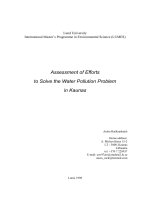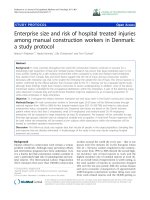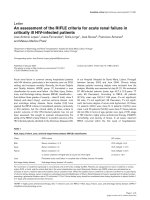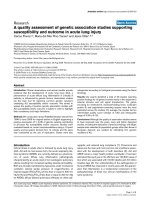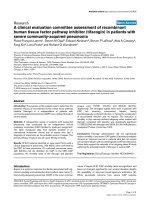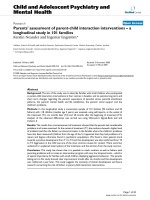Assessment of KAP towards BLS among dental medicine interns in selected health colleges, addis ababa ethiopia
Bạn đang xem bản rút gọn của tài liệu. Xem và tải ngay bản đầy đủ của tài liệu tại đây (438.42 KB, 49 trang )
Addis Ababa University School of Graduate Studies
School of Medicine
Department of Emergency Medicine and Critical Care
Assessment of KAP towards BLS among dental
medicine interns in selected health colleges, Addis
Ababa Ethiopia
A thesis submitted to school of graduate studies of Addis Ababa
University, Department of Emergency Medicine and Critical
Care in partial fulfillment of the requirements for degree of
masters in Emergency medicine and critical care nursing.
June 2017, Addis
a
APPROVED BY THE BOARD OF EXAMINERS
This thesis by Abubeker Hussen is accepted in its present form by the board of
examiners as satisfying thesis requirement for the degree of Masters of Science in
Emergency medicine and critical care nursing.
Examiner:
____________________ ____________________ _______________
Full name
Rank
Signature and Date
Advisors:
____________________ ____________________ _____________________
Full name
Rank
Signature and Date
____________________ ____________________ _____________________
Full name
Rank
Signature and Date
b
c
Table of contents
Contents
Table of contents ............................................................................................................................................ i
Acknowledgment ........................................................................................................................................... i
Acronyms ....................................................................................................................................................... i
List of tables................................................................................................................................................... i
List of figures ................................................................................................................................................. i
Abstract .......................................................................................................................................................... i
1. Introduction ................................................................................................................................................ i
1.1 Background of the study ...................................................................................................................... i
1.2 Statement of the Problem ..................................................................................................................... i
1.3 Significance of the Study ..................................................................................................................... i
2. Literature Review..................................................................................................................................... i
2.1 BLS Knowledge ................................................................................................................................... i
2.2 Attitude towards BLS .......................................................................................................................... i
2.3 Practices towards BLS ......................................................................................................................... i
2.4 Conceptual framework ............................................................................................................................. i
3. Objectives .................................................................................................................................................. i
3.1 General Objective ................................................................................................................................ i
3.2 Specific objectives ............................................................................................................................... i
4. Methods and Materials ............................................................................................................................... i
4.1. Study Setting ....................................................................................................................................... i
4.2 Study design ......................................................................................................................................... i
4.3. Source Population ............................................................................................................................... i
4.4. Study population ................................................................................................................................. i
4.5. Inclusion and exclusion Criteria ......................................................................................................... i
4.5.1 Inclusion Criteria .............................................................................................................................. i
4.5.2 Exclusion Criteria ............................................................................................................................. i
4.6 Sample size determination ................................................................................................................... i
4.7 Sampling Technique ............................................................................................................................ i
i
4.8. Study Variables .................................................................................................................................. ii
4.8.1 Dependent Variables .................................................................................................................... ii
4.8.2 Independent Variables.................................................................................................................. ii
4.9. Data Collection and Quality Control procedures ............................................................................... ii
4.10. Operational definition of terms ........................................................................................................ ii
4.11. Data processing and analysis ........................................................................................................... ii
4.12 Ethical consideration ......................................................................................................................... ii
4.13 Dissemination and utilization of results ............................................................................................ ii
5. Results ....................................................................................................................................................... ii
5.1 Introduction ......................................................................................................................................... ii
5.2 Demographic characteristics of the study participants........................................................................ ii
5.3 Knowledge of Basic Life Support among the study participants ........................................................ ii
5.4 The study participant’s attitude towards Basic Life Support .............................................................. ii
5.5 The study participant’s practice regarding Basic Life Support ........................................................... ii
5.6 Association of knowledge with independent variables ....................................................................... ii
5.7 Association of attitude of dental internes towards BLS with independent variables .......................... ii
6. Discussion.................................................................................................................................................. ii
7: Conclusion, Recommendation and Limitations of the study .................................................................... ii
7.1: Conclusion and Recommendations ................................................................................................... ii
7.2: Limitations ......................................................................................................................................... ii
References ..................................................................................................................................................... ii
Annex ............................................................................................................................................................ ii
Annex I. Information Sheet....................................................................................................................... ii
Annex II. Consent sheet ............................................................................................................................ ii
Annex III: Questionnaire ......................................................................................................................... ii
ii
Acknowledgment
I am extremely grateful to the efforts exerted by my colleagues who facilitated the
successful completion of this research proposal. I would also like to extend my
deepest gratitude to my advisors; for their time, effort and valuable comments and
directions they gave in the preparation of this thesis
I also thank AAU for the chance given to me to pursue my master’s study. And I
am grateful for Atlas Health Science College and AAU School of Dental Medicine
for letting me conduct my study in their premises.
iii
Acronyms
AED
Automated External Defibrillator
AHA
American Heart Association
BLS
Basic Life Support
CPR
Cardio Pulmonary Resuscitation
EMS
Emergency Medical Service
KAP
Knowledge Attitude Practice
MMV
Mouth to Mouth Ventilation
SCA
Sudden Cardiac Arrest
iv
List of tables
Table 1: Name of the Dental Medicine School at which the dental interns
attending……...........................................................................................................................…15
Table 2: Demographic characteristics of study participants in the study assessment of KAP
regarding BLS among dental interns at selected health science colleges Addis Ababa
Ethiopia,
2017…………………………………………………………………………………………….16
Table 3: Knowledge of the study participants towards Basic Life Support in the study
assessment of KAP regarding BLS among Dental internes at selected health science colleges
Addis Ababa, Ethiopia 2017…………………………………………………………………17
Table 4: Opinions of participants towards Basic Life Support in the study of assessment of
KAP regarding BLS among Dental internes at selected health science colleges Addis
Ababa, Ethiopia 2017………………………………………………………………………….19
Table 5: Study participants practice of Basic Life Support in the study assessment of KAP
regarding BLS among dental internes at selected health science colleges, Addis Ababa,
Ethiopia 2017…………………………………………………………………………………..20
Table 6: Bivariate and multivariate logistic regression analysis of Knowledge status and the
independent Variables…………………………………………………………………………21
Table 7: Bivariate and multivariate logistic regression analysis of Attitude and
the independent Variables………………………………………………………….22
v
List of figures
Figure 1 Conceptual frame work for assessment of knowledge, attitude and practice among
dental internes regarding BLS, developed from literatures.....................................................8
Figure 2 Study participants' BLS workshop attendance.........................................................17
Figure 3 Study participants’ attitude towards BLS ................................................................20
vi
Abstract
Background of the study: Life-threatening emergencies can occur at anytime, anywhere and to
anyone. Such emergencies are somewhat more likely to occur within the confined dental office
due to the increased level of stress which is often present. Basic life support (BLS) is the
foundation for saving life following cardiac arrest. Fundamental aspects of BLS include
recognition of Sudden Cardiac Arrest (SCA) and activation of the emergency response system,
early Cardiopulmonary Resuscitation (CPR), and rapid defibrillation with an Automated
External Defibrillator (AED).
Objective of the study: To determine KAP of internes studying dental medicine towards BLS at
Atlas Health Science College and Addis Ababa University School of Dental Medicine, Addis
Ababa, Ethiopia 2017.
Methods and Materials: Institution based prospective study was conducted at selected health
science colleges in Addis Ababa, in titled ‘assessment of KAP among internes studying dental
medicine towards BLS’ from January to June 2017. The study sample was selected using
convenience non random sampling since the interns studying Dental Medicine at Atlas Health
Science College and AAU School of Dental Medicine were limited in number. Data analysis of
the study was conducted using SPSS version 20; descriptive and analytical statistics were done.
Results: Most of the participants 76 (66.7%) know the adult chest compression depth. Whereas
57 (50%) of the participants have reported their reluctance to perform resuscitation. It was found
that sex of the dental interns is significantly associated with their knowledge regarding BLS;
female study participants were likely to have 5 times more knowledge regarding BLS than their
male counter parts with AOR= 5.3299, at 95% CI (2,373, 12,282). As well those dental internes
with less than 5 years clinical experience are more likely to have positive attitude towards BLS;
with AOR=0.157 at 95 CI (0.062,0.399).
Conclusion: Knowledge and Practice skills of BLS were found to be poor among the dental
internes in the study. A significant portion of the study participants have shown negative attitude
towards providing BLS. An organized curriculum for BLS should be part of the dental medicine
curriculum with much higher emphasis.
vii
Keywords: Basic life support; BLS Knowledge; BLS Attitude; BLS practice
viii
1. Introduction
1.1 Background of the study
Life-threatening emergencies can occur at anytime, anywhere and to anyone. Such emergencies
are somewhat more likely to occur within the confined dental office due to the increased level of
stress which is often present. Effective management of an emergency in the dental office is
ultimately the dentist’s responsibility. The lack of training and inability to cope with medical
emergencies can lead to tragic consequences and sometimes legal complications. Therefore,
health professionals including dentists must be well prepared to manage medical emergencies.
Hence, BLS is an important tool until a medical emergency can be treated (1).
Basic life support (BLS) is the foundation for saving life following cardiac arrest. Fundamental
aspects of BLS include recognition of sudden cardiac arrest (SCA) and activation of the
emergency response system, early cardiopulmonary resuscitation (CPR), and rapid defibrillation
with an automated external defibrillator (AED) (2). Initial recognition and response to heart
attack and stroke are also considered part of BLS. BLS also includes supporting breathing,
circulation and maintaining an airway without using any equipment other than a simple airway
device or protective shield (3). The main purpose of BLS is to maintain adequate ventilation and
circulation till resources can be obtained to reverse the underlying cause of arrest (4).
Knowledge of BLS and expertise in CPR techniques ensures the survival of the patient long
enough till experienced medical help arrives and in most of the cases CPR by itself is sufficient
for survival (5). Different factors may affect the quality of CPR; such as feedback, education and
monitoring and it have been emphasized that these should be developed together in order to
improve quality (6).
Medical emergencies can commonly occur on the dental chair but fortunately serious
complications have not been associated (3, 4). It is the utmost duty of dental practitioners
including specialists to sustain life until medical help arrives in order to reduce chances of
mortality and morbidity (7, 8, 9).
1
The golden rule in managing any emergency is by rendering BLS, CPR by following the basic
principles which include position, airway, breathing, circulation, and definitive therapy
In a study conducted in Belgaum city, India it was found that overall in all the years, syncope /
faint was seen by 40.9% of the respondents, 37.1% with hypoglycemic attacks, allergic reactions
by 17.1%, epileptic attacks by 7.6%, asthmatic attacks by 4.5% and angina 0.9%. The
frequencies of the emergencies encountered were once or even more. Knowledge of the presence
of drugs and equipment in the emergency drug kit and the confidence in regard to use them was
low. Medical emergencies training were undertaken by 42% respondents, but in varying degrees.
There was a desire for further medical emergencies training by majority of respondents (9).
An increasing proportion of the population is medically at risk. According to the European
resuscitation council, sudden cardiac arrest is a leading cause of death in Europe, affecting about
7, 00,000 individuals a year (29). Although a number of studies have been carried out which
sought to ascertain the emergency drugs and equipment, the lack of training and inability to cope
with medical emergencies can lead to tragic consequences and sometimes legal action (9). For
this reason, as all the health professionals, dentists must be well prepared to attend to and
collaborate with the medical emergencies (10).
Although necessary knowledge is given at undergraduate level; but to maintain and update
knowledge about recent advances periodic BLS courses should be made mandatory (11).
Few studies have assessed how competent dentists consider themselves in managing medical
emergencies, and very few studies to my knowledge have reported studies involving dental
interns (19).
2
1.2 Statement of the Problem
As health care professionals, dental practitioners encounter life-threatening medical emergencies.
A study by M P Müller et al. (17) found that medical emergencies are not rare in dental practice,
as about two- third of dentists faced at least one emergency during the 12- month study period. In
this study period, 57% of the dentists reported up to 3 emergencies and 36% of the dentists
reported up to 10 emergencies. Vasovagal syncope was the most frequent emergency (1238
cases). As two cardiac arrests occurred, it is estimated that one sudden cardiac arrest occurs per
638, 960 patients in dental practice. 42 severe life-threatening events were reported in all
1, 277, 920 treated patients. 567 dentists (92%) took part in emergency training following
graduation (23% participated once and 68% more than once). In the context of medical
emergencies, provision of a competent BLS carries a potential impact on lives.
About half of the patients visiting a dental office have one or the other chronic disease or
condition. Few diseases and their treatments lead to medical emergencies during dental care or
dental treatments. Although a number of studies were conducted to improvise the availability of
emergency drugs and equipment, the lack of training and inability to cope with medical
emergencies can lead to tragic consequences and sometimes legal action (20, 21, and 22). All
emergencies may not be life-threatening but the ability of a dentist to manage them play a key
role in minimizing morbidity and mortality.
A study by Shrestha R. et al. (27) revealed that the participants had inadequate knowledge on
BLS. Although 52% of the participants answered ≥7 of the 15 questions, only 7.4% (n=9) of
them could answer 75% of the questions correctly. Other studies also demonstrated inadequate
CPR knowledge in health care professionals (18, 28, 29).
Studies on BLS have been rarely conducted among dental students. This institution based
prospective study will be carried out to assess the knowledge, attitude and practice towards BLS
among dental interns in Addis Ababa city.
3
1.3 Significance of the Study
In Ethiopia, no previous published studies have been found in any data base regarding the need
of BLS in a dental set up. It is essential for all dentists, be it in public or private sector, to be
equipped with the required knowledge, apparatus and drugs. The aim of this study is to assess the
awareness of dental interns about the possible risks of a medical emergency in dental care and
assess their knowledge, attitude and practice regarding BLS.
Even though previous studies all over the world have been conducted regarding the awareness of
BLS among students, doctors, and nurses of medical, dental & nursing colleges and found to be
very poor which needed improvement. This study will try to assess the KAP among interns
studying dental medicine at Selected Health Science College’s in Addis Ababa. The study results
would be of paramount importance to focusing for consideration in including BLS trainings
while developing dental medicine curriculum.
Cardiac arrest continues to be a major cause of premature death in much of the world today.
Although the epidemiology of cardiac arrest and other emergencies have been well studied in
many developed countries, there are still no studies done on assessments of knowledge, attitude
and practice on BLS among interns studying dental medicine in Ethiopia. This study may
provide baseline information for other researchers and health professionals who are interested on
the same area. Besides this might initiates responsible bodies to treat cardiac arrest patients in
order to take action and further increment of awareness at dental health care provision centers
and institutes providing dental health education about the importance of proper training on BLS.
4
2. Literature Review
The life of an individual is influenced by various factors including the condition of health,
education, occupation, and socioeconomic status. Among the various factors, the condition of
health influences the life of an individual to a greater extent. There are various systemic
conditions of health like myocardial infarction, congestive cardiac failure, and stroke which may
cause even sudden death of an individual. There are different ways by which the occurrence of
death of an individual may be prevented. They include the instructions given and medications
prescribed by health professionals, diet, and physical exercises. In addition to these ways, BLS in
case of medical emergencies is most important. BLS refers to maintaining an airway and
supporting breathing and circulation without using any equipment (12).
The American Heart Association (AHA) resuscitation guidelines recommend that all under
graduate students who are in contact with the patients should have regular resuscitation training
(12,14).
Each individual in a community should know the importance of BLS in saving lives and
improving the quality of community health (13). Effective management of an emergency in the
dental office is ultimately the dentist's responsibility. The lack of training and inability to cope
with medical emergencies can lead to tragic consequences and sometimes legal complications.
Therefore, health professionals including dentists must be well prepared to manage medical
emergencies. Hence, BLS is an important tool until a medical emergency can be treated (14).
Emergencies do occur in the dental office. Minimal knowledge about these incidents leads to
feelings of insecurity, dissatisfaction or limited appreciation of responsibility of dentists. The
inability to perform proper BLS in the dental office will be the ultimate consequence (14).
2.1 BLS Knowledge
5
Knowledge of BLS and practice of simple CPR techniques increase the chances of survival of
the patient until experienced medical help arrives and, in most cases, is sufficient for survival in
itself (15).
In a study conducted in Bangalore city, India the knowledge scores of interns were marked as
poor, average, and good. Which was found to be among 102 interns, 18 (17.6%) had poor
knowledge, 64 (62.7%) had average knowledge, and 20 (19.6%) had good knowledge about BLS
(16).
In a study conducted in Salem, Tamilnadu, India it was found that 31% of the responders did not
know the abbreviation of BLS as Basic life support. 59 % failed to insist on looking for safety as
the first step in BLS. 89% failed to insist on activating EMS immediately after confirming the
unresponsiveness in an adult. 74% did not know that the right location of chest compression was
the mid chest. 73% of the responders did not know that the correct location of chest compression
in an infant was one finger breadth just below the nipple line. 83% of the responders did not
know alternative techniques of resuscitation when mouth-to-mouth ventilation was not opted.
84% of the responders failed to select mouth-to-mouth and nose technique as the rescue
breathing for infants. 67% did not know that the depth of chest compression in an adult was 1.5
to 2 inches. 83% did not know that the depth of chest compression in a child was one-third to
one-half the depth of the chest. 35% did not know that the chest compression in an infant was
one-third to one-half the depth of the chest. Only 35% of the responders answered the rate of
chest compression as 100/minute in adults and children CPR. Only 15% of the responders had
correctly answered that the compression ventilation ratio in a child and adult single rescuer CPR
was 30:2. Only 26% knew that the ratio of compression ventilation in a new born was 3:1. 60%
of the responders did not know that the abbreviation of AED was ‘automated external
defibrillator’, and only 56% knew that the abbreviation of EMS was ‘Emergency Medical
Service’. 84% did not know that the first step in helping a suspected foreign body obstruction
victim is to confirm the severity of obstruction by talking to him. Only 30% were aware about
the right technique of foreign body removal from an infant (19).
In the same study only 13% knew about the role of the recovery position in a spontaneously
breathing unresponsive victim. 66% of the responders did not know the early signs of stroke and
only 54% per cent knew how to recognize and help a patient with acute coronary syndrome (19).
6
Looking closely at the individual groups 83% of the medical students, 65% of the medical
interns, 89% of the dental students, 93% of the dental interns, 99% of the homeopathy interns,
98.4% of the nursing students, 69% of pre- and para-clinical doctors, 59% of the practicing
doctors, 83% of the dentists and 83% of the homeopathy doctors had scored less than 50% of the
marks (18).
2.2 Attitude towards BLS
In a study conducted in India, the attitude of interns was classified as positive and negative
respectively. Of all the interns, 69 (67.6%) had a positive attitude towards BLS and 33 (32.4%)
had a negative attitude towards BLS (16).
In the study conducted by Varma L et al.(25) only 50.5% of the dentists were confident in
managing any emergency condition at their dental offices, which was similar to the findings in a
study done by Muller and Broadbent, whereas the remaining had an attitude of calling an
ambulance in case of emergency conditions (22).
2.3 Practices towards BLS
It is recommended that all medical students and staff, who are exposed to patients, must be
trained to offer basic life support (18).
In the study conducted by Varma L et al. 87.2% of the practitioners had emergency kits at the
dental office to handle medical emergencies, but this was in contrast to the findings (8.9%) in a
study done by Gbotolorun et al. (25, 26).
Gonzaga et al. (10) found that theoretical information without practical training is not enough to
assure CPR competence. Practical assessment is difficult to be performed through a
questionnaire. Practical skills could not be assessed in the present study however; we focused on
the cognitive levels of BLS.
A study conducted to assess the preparedness of dental practitioners toward medical emergencies
by enquiring about the key start points such as medical history, drug history, vital signs of the
7
patients, and availability of emergency drug kits at their dental office. 94.02% of the total
practitioners enquired about medical and drug history, but only 67.11% of them obtained filled
Performa and about 83.06% recorded vital signs. All the above findings were high when
compared to a similar study conducted by Kumarswami et al. which was mainly due to increase
in the awareness regarding medical emergencies among dentists (25).
2.4 Conceptual framework
Attended BLS
workshop
Clinical
experience
Knowledge
about BLS
Gender
Attitude
about BLS
Age
Practice about
BLS
Figure 1 Conceptual frame work for assessment of knowledge, attitude and practice among
dental internes regarding BLS, developed from literatures.
8
3. Objectives
3.1 General Objective
To determine KAP of internes studying dental medicine towards BLS in Atlas Health
Science College and Addis Ababa University School of Dental Medicine Addis Ababa,
Ethiopia, November to June 2017.
3.2 Specific objectives
To determine the Knowledge of interns studying dental medicine towards BLS.
To determine the associated factors with the attitude of interns studying dental medicine
towards BLS.
To identify the level of practice among interns studying dental medicine towards BLS.
9
4. Methods and Materials
4.1. Study Setting
A cross sectional prospective institution based study was conducted from November to June
2017. The study was conducted in Dental Medicine Schools found in Addis Ababa. In 2017 a
total of eight dental medicine institutes were present in the country, of which four were found in
Addis, of the four dental medicine institutes one was governmental and the remaining three were
private. The schools are Atlas Health Science College, Addis Ababa University School of Dental
Medicine, Africa Health Science College and Sante Health Science College. Since the Study is
conducted on dental medicine interns Africa and Sante Health Science Colleges weren’t included
in the study because they didn’t have dental medicine interns currently.
The study was
conducted in AAU School of Dental Medicine and Atlas Health Science College. Atlas Health
Science College was established on the year 2005G.C. having three departments. Since then the
college has graduated more than 80 dentists. The college has 300 students for the year 2017 of
which 100 of them are dental medicine internes. AAU School of Dental Medicine has 20 dental
medicine interns for the current 2016/2017 academic year. AAU School of Dental Medicine has
graduated its first dental physicians 22, on the year 2008 E.C.
4.2 Study design
A cross sectional prospective institution based study was conducted from November to June
2017 to investigate the KAP of dental medicine interns towards BLS in selected Health Science
Colleges in Addis Ababa.
4.3. Source Population
The source populations for the study were students studying dental medicine at selected dental
medicine institutes at Addis Ababa, Ethiopia.
4.4. Study population
10
The study population for this study was dental medicine interns of the 2017 academic year at the
selected Health Science Colleges, Addis Ababa.
4.5. Inclusion and exclusion Criteria
4.5.1 Inclusion Criteria
- Dental medicine interns at Atlas Health Science College and AAU School of Dental Medicine.
- Willingness to participate in the study
4.5.2 Exclusion Criteria
- Not being in the Colleges at the time of data collection.
- Not being willing to participate in the study.
4.6 Sample size determination
The sample size for this study was all interns studying dental medicine at Atlas Health Science
College and AAU School of Dental Medicine Addis Ababa, Ethiopia. Hence the number of
dental medicine interns at the institutions was very few; the study sample included all the dental
medicine interns at the institutions’.
4.7 Sampling Technique
From the Schools record using convenient sampling technique all interns studying dental
medicine at Atlas Health Science College and AAU School of Dental Medicine were included in
the study hence the study population were limited in number.
4.8. Study Variables
4.8.1 Dependent Variables
KAP of dental internes towards BLS
4.8.2 Independent Variables
Socio demographic characteristics
Work experience/ clinical experience
Previous BLS training
11
4.9. Data Collection and Quality Control procedures
A structured self-administered questionnaire was used to collect data. The questionnaire was
adapted from previous studies. The questionnaire was prepared in English. Training was given
for the data collectors for 2 days prior to the pretest and for 1 day after the pretest. The content of
the training for the data collectors included how to collect data, general objective, relevance of
the study, and confidentiality of information. While conducting training to the data collectors the
training was conducted in the form of discussion going through the structured questionnaire. To
assure the data qualities the principal investigator has checked all the collected data for
completeness, consistency, and clarity during data management, storage, and analysis.
.
The pre-test was conducted on study participants prior to the study on a total of 10% of the
sample size at AAU School of Dental Medicine. The pretest was conducted among the 5th year
dental medicine students of AAU School of Dental Medicine. The questionnaires passed through
a pre - test, to make sure it measured what it intended to measure. After the pre-testing the
questionnaire was checked for its clarity, simplicity, understandability and coherency. Correction
was made based on the feedback. For confusing words and phrases, locally known and
comparable terms were used.
The study entitled assessment of KAP regarding BLS among dental interns at selected Health
Science Colleges, Addis Ababa Ethiopia; the data collection was conducted from April 20 to
May 10, 2017.
4.10. Operational definition of terms
Knowledge: Respondent who answers greater and equal to 50 % of the total knowledge
questions are classified as having sufficient knowledge, and who answers less than 50 % of
the total knowledge question are classified as having insufficient knowledge about BLS.
12
Attitude: It refers to correct response of interns of dental medicine students regarding to
BLS for selected emergencies to the structured attitude questionnaire adapted from other
studies by the investigator for this study.
Practice: It refers to academic application of knowledge and skills on CPR.
Basic life support: Maintaining air way, breathing and circulation for patients with cardiac
arrest and other emergencies without drug administration.
4.11. Data processing and analysis
The raw data was checked for any inconsistencies, coding error, out of range, and missing values
and appropriate corrections were made. The analysis was done using SPSS version (20).
Descriptive analyses of socio demographic information, knowledge, attitude and practice was
carried out.
Association between variables were tested with Chi Square Test, Bivariate logistic regression
model was used to assess association of independent variables with the outcome variable and
calculate the crude (COR) and adjusted odds ratios (AOR).
For knowledge assessment the participants who scored ≥ 50 % of the total questions correctly
were classified as having sufficient knowledge whereas who scored < 50 % of the total questions
were classified as having insufficient knowledge .
4.12 Ethical consideration
Letter of ethical clearance was obtained from the ethical review committee of school of
Medicine, Addis Ababa University and letter of permission from authorities of Atlas Health
Science College and AAU School of Dental Medicine was obtained to conduct the study in the
colleges’ premises. A written informed consent was obtained prior to data collection from each
study participants.
Confidentiality was ensured as the names of the study participants were not included in the data
collection as well in data analysis.
13
4.13 Dissemination and utilization of results
The result of the study will be submitted and presented to AAU, School of Graduate Studies, and
School of Medicine Department of Emergency Medicine. Then it will be disseminated to AAU
School of Dental Medicine and Atlas Health Science College. Then it will be presented in a
national and international conferences and it will also be processed to be published in scientific
journals nationally as well as internationally.
14

